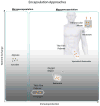Stem Cell Therapies for Treating Diabetes: Progress and Remaining Challenges
- PMID: 29859172
- PMCID: PMC6007036
- DOI: 10.1016/j.stem.2018.05.016
Stem Cell Therapies for Treating Diabetes: Progress and Remaining Challenges
Abstract
Restoration of insulin independence and normoglycemia has been the overarching goal in diabetes research and therapy. While whole-organ and islet transplantation have become gold-standard procedures in achieving glucose control in diabetic patients, the profound lack of suitable donor tissues severely hampers the broad application of these therapies. Here, we describe current efforts aimed at generating a sustainable source of functional human stem cell-derived insulin-producing islet cells for cell transplantation and present state-of-the-art efforts to protect such cells via immune modulation and encapsulation strategies.
Copyright © 2018. Published by Elsevier Inc.
Figures


Similar articles
-
Scalable production of pancreatic islet progenitors for diabetes cell therapies.Med J Malaysia. 2008 Jul;63 Suppl A:5-6. Med J Malaysia. 2008. PMID: 19024957
-
Stem cells in diabetes: what has been achieved.Horm Res. 2003;60 Suppl 3:10. doi: 10.1159/000074493. Horm Res. 2003. PMID: 14671389
-
Lessons from Human Islet Transplantation Inform Stem Cell-Based Approaches in the Treatment of Diabetes.Front Endocrinol (Lausanne). 2021 Mar 11;12:636824. doi: 10.3389/fendo.2021.636824. eCollection 2021. Front Endocrinol (Lausanne). 2021. PMID: 33776933 Free PMC article. Review.
-
Recent progress in modeling and treating diabetes using stem cell-derived islets.Stem Cells Transl Med. 2024 Oct 10;13(10):949-958. doi: 10.1093/stcltm/szae059. Stem Cells Transl Med. 2024. PMID: 39159002 Free PMC article. Review.
-
Microchip-based engineering of super-pancreatic islets supported by adipose-derived stem cells.Biomaterials. 2014 Jun;35(17):4815-26. doi: 10.1016/j.biomaterials.2014.02.045. Epub 2014 Mar 15. Biomaterials. 2014. PMID: 24636217
Cited by
-
Clinical Outcomes of Fetal Stem Cell Transplantation in Type 1 Diabetes Are Related to Alternations to Different Lymphocyte Populations.Med J Islam Repub Iran. 2022 Apr 13;36:34. doi: 10.47176/mjiri.36.34. eCollection 2022. Med J Islam Repub Iran. 2022. PMID: 36128298 Free PMC article.
-
The response of three-dimensional pancreatic alpha and beta cell co-cultures to oxidative stress.PLoS One. 2022 Mar 15;17(3):e0257578. doi: 10.1371/journal.pone.0257578. eCollection 2022. PLoS One. 2022. PMID: 35290395 Free PMC article.
-
Revisiting the Pathogenesis of Type 1 Diabetes: Importance of Neural Input to Pancreatic Islets and the Therapeutic Capability of Stem Cell Educator TM Therapy to Restore Their Integrity.Biomedicines. 2023 Feb 16;11(2):594. doi: 10.3390/biomedicines11020594. Biomedicines. 2023. PMID: 36831130 Free PMC article. Review.
-
Generation of insulin-producing pancreatic β cells from multiple human stem cell lines.Nat Protoc. 2021 Sep;16(9):4109-4143. doi: 10.1038/s41596-021-00560-y. Epub 2021 Aug 4. Nat Protoc. 2021. PMID: 34349281 Free PMC article.
-
The Diurnal Variation in Mitochondrial Gene in Human Type 2 Diabetic Mesenchymal Stem Cell Grafts.Int J Mol Sci. 2025 Jan 16;26(2):719. doi: 10.3390/ijms26020719. Int J Mol Sci. 2025. PMID: 39859433 Free PMC article.
References
-
- Agulnick AD, Ambruzs DM, Moorman MA, Bhoumik A, Cesario RM, Payne JK, Kelly JR, Haakmeester C, Srijemac R, Wilson AZ, Kerr J, Frazier MA, Kroon EJ, D’Amour KA. Insulin-Producing Endocrine Cells Differentiated In Vitro From Human Embryonic Stem Cells Function in Macroencapsulation Devices In Vivo. Stem Cells Transl Med. 2015;4:1214–1222. doi: 10.5966/sctm.2015-0079. - DOI - PMC - PubMed
-
- Balamurugan AN, Naziruddin B, Lockridge A, Tiwari M, Loganathan G, Takita M, Matsumoto S, Papas K, Trieger M, Rainis H, Kin T, Kay TW, Wease S, Messinger S, Ricordi C, Alejandro R, Markmann J, Kerr-Conti J, Rickels MR, Liu C, Zhang X, Witkowski P, Posselt A, Maffi P, Secchi A, Berney T, O’Connell PJ, Hering BJ, Barton FB. Islet product characteristics and factors related to successful human islet transplantation from the Collaborative Islet Transplant Registry (CITR) 1999–2010. Am J Transplant. 2014;14:2595–2606. doi: 10.1111/ajt.12872. - DOI - PMC - PubMed
-
- Barkai U, Weir GC, Colton CK, Ludwig B, Bornstein SR, Brendel MD, Neufeld T, Bremer C, Leon A, Evron Y, Yavriyants K, Azarov D, Zimermann B, Maimon S, Shabtay N, Balyura M, Rozenshtein T, Vardi P, Bloch K, de Vos P, Rotem A. Enhanced oxygen supply improves islet viability in a new bioartificial pancreas. Cell Transplant. 2013;22:1463–1476. doi: 10.3727/096368912X657341. - DOI - PubMed
-
- Barton FB, Rickels MR, Alejandro R, Hering BJ, Wease S, Naziruddin B, Oberholzer J, Odorico JS, Garfinkel MR, Levy M, Pattou F, Berney T, Secchi A, Messinger S, Senior PA, Maffi P, Posselt A, Stock PG, Kaufman DB, Luo X, Kandeel F, Cagliero E, Turgeon NA, Witkowski P, Naji A, O’Connell PJ, Greenbaum C, Kudva YC, Brayman KL, Aull MJ, Larsen C, Kay TWH, Fernandez LA, Vantyghem MC, Bellin M, Shapiro AMJ. Improvement in outcomes of clinical islet transplantation: 1999–2010. Diabetes Care. 2012;35:1436–1445. doi: 10.2337/dc12-0063. - DOI - PMC - PubMed
-
- Basta G, Montanucci P, Luca G, Boselli C, Noya G, Barbaro B, Qi M, Kinzer KP, Oberholzer J, Calafiore R. Long-term metabolic and immunological follow-up of nonimmunosuppressed patients with type 1 diabetes treated with microencapsulated islet allografts: four cases. Diabetes Care. 2011;34:2406–2409. doi: 10.2337/dc11-0731. - DOI - PMC - PubMed
Publication types
MeSH terms
Substances
Grants and funding
LinkOut - more resources
Full Text Sources
Other Literature Sources
Medical

